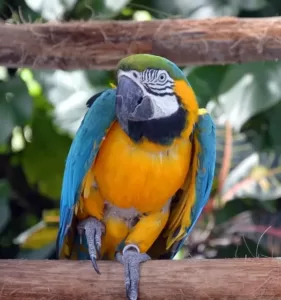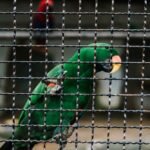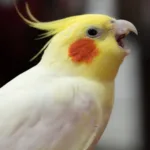Parrots have a unique tendon-locking mechanism that affords them superior balance, even when standing on one leg. While you may be concerned to see your parrot frequently lifting one foot up, it is actually a common behavior that serves important functions for them.
Parrots often stand on one leg to conserve body heat. By tucking one foot inside their feathers, they prevent heat from escaping through the unfeathered legs. This is also a convenient sleeping position for parrots as it allows them to maintain balance even during REM sleep.
It is usually nothing to be concerned about, however, if a parrot constantly switches between legs or seems to use one foot more than the other, it could be an indication of injuries or underlying foot-related conditions.
Quick Navigation
Why Do Parrots Stand On One Leg?
The one-foot stance has several plays few important functions. Parrots stand on one foot for a few different reasons including preventing heat loss, saving energy, and sleeping comfortably. Here are the common reasons why parrots perch on one leg:
Conserving Body Heat
One of the common reasons parrots stand on one leg is to keep warm by reducing heat loss from their unfeathered areas. Since their legs are the only area of their body that is not covered in feathers, it can let heat escape. So, parrots tuck one of their legs under the feathers in order to prevent heat from escaping.
This behavior is more common in winter or when the room temperatures are too cold for the parrot. You may see your parrot puff up its feathers and lift up one leg to keep itself warm.
According to a study published in the Journal Of Avian Biology birds with longer legs, relative to their body size, are more likely to stand on one leg, especially in colder temperatures. This is because birds with shorter legs have less leg surface to lose heat from.
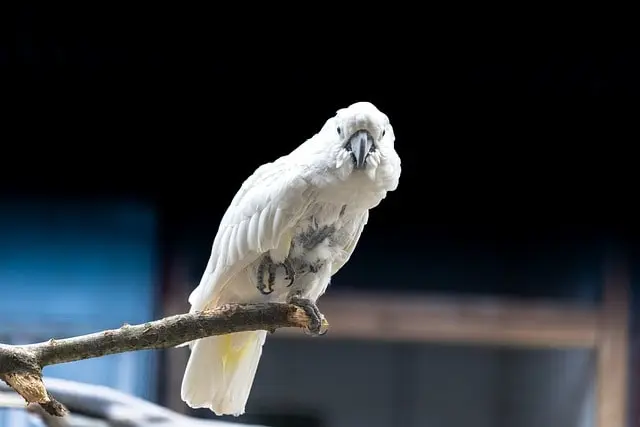
Ideal Sleeping Position
Lifting one foot up is a preferred sleeping position for most parrots. Parrots like sleeping standing up because it helps them stay warm and cozy. Not only does it keep their body warm, but it also provides excellent stability.
Although it may seem like it, sleeping on one leg does not compromise a parrot’s balance. All parrots have a tendon-locking mechanism that allows them to perch upright even when they’re sleeping.
When a parrot sits on its perch, the tendon at the back of the leg automatically tightens, making the foot grip the perch firmly.
It acts like a lock that holds the parrot’s body in place even when it is in deep sleep. This way, parrots can sleep comfortably using just one leg without worrying about falling off.
Resting One Leg
Parrots often alternate between legs while perching. Since they stand in an upright position all day, they need to rest their legs after a while. It is similar to how we may take the weight off one foot after standing in the same position for a prolonged period.
Standing on one leg helps parrots save energy and keep their legs from tiring. While this posture might seem quite unstable to us, it actually allows parrots to use less energy while standing. Parrots can comfortably stand on one leg while simultaneously resting the other.
Comfort
Sometimes, parrots may lift up one leg to rest and unwind. Lifting one foot momentarily takes the load off and helps the parrot relax. While it does put more weight on one leg, it also allows parrots to conserve energy because the foot is secured in its place and doesn’t require any effort to balance.
Is It Normal For Parrots To Stand On One Foot?
It is normal for parrots to stand on one leg as long as it is not an attempt to avoid using the other leg. When parrots stand on one leg, they can tuck the other leg close to their body, reducing heat loss.
However, if you notice that your parrot constantly avoids using one leg or appears to be in pain, it can be a sign of an injury or health condition. Under certain circumstances, it may not be normal for your parrot to stand on one foot.
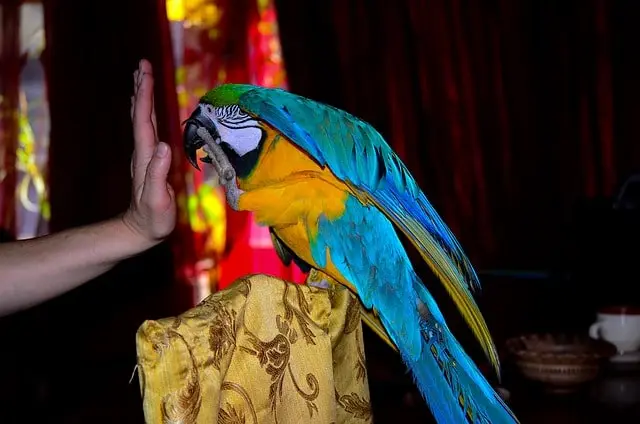
Injuries
If your parrot only uses one foot, it could be because the other foot is hurt. The parrot may be trying to alleviate the pain by avoiding putting pressure on it.
According to MSD Veterinary Manual an injury in one leg can cause the bird to shift the body weight to the other leg, placing more pressure on it, which can potentially lead to ulceration of the foot.
Bumblefoot
If your parrot’s foot appears to have scabs and reddening, it can suggest that it has developed bumblefoot. Bumblefoot in parrots occurs when the foot gets infected by bacteria entering through a cut or skin wound.
At first, the foot may have mild discomfort and the parrot may choose to hold it up. However, the condition can progress quickly if not treated in time. As the condition exacerbates, the parrot may show other behavioral signs like limping, going to the cage floor, and refusing to perch.
If there are visible signs of swelling and the foot appears to be in a bad condition, take your parrot to the vet immediately.
Arthritis
Arthritis is a common condition in older parrots and those with a history of foot injuries. A parrot with arthritis will constantly stand on one foot as its legs may tire quickly. Switching legs while standing helps alleviate the discomfort and strain caused by arthritis.
Sometimes, arthritic parrots may occasionally avoid perching altogether, if it causes them too much discomfort. These behaviors can often be subtle signs of your parrot’s foot condition.
Gout
Avian gout is a more severe form of arthritis. It is caused by the accumulation of uric acid in the joints. Kidney failure is often the main cause of gout.
It is a painful condition which can make perching difficult for parrots. The parrot may instinctively lift one leg in an attempt to alleviate the discomfort on the affected foot.
However, a parrot with gout will not be able to stand normally on its perch for long. Soon it may resort to sitting at the bottom of the cage. Symptoms of avian gout can be clearly seen on the parrot’s foot. Some common signs include swelling and reddening of the foot. The parrot’s feet may also be warm.
FAQs
Why Do Parrots Raise Their Foot When You Walk Up To Them?
Parrots may raise their foot when you approach them for several reasons. If you’ve been away from them for a long time, it can mean your parrot is greeting you with its foot. It can also mean that your parrot is trying to get your attention and asking you to come play.
Parrots sometimes raise their foot because they want to climb on you and perch on your parrot. If your parrot is trained to step up, it may just be asking to get picked up when you walk up to them.
Do All Parrots Stand On One Leg?
The uni-pedal stance is a common trait among all parrot species. Parrots of all sizes with different leg lengths including the lorikeets, African greys, macaws, and Quaker parrots, are capable of standing on foot. It is something that comes naturally to them and serves an important function.
